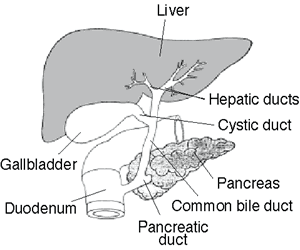On this page
- What is primary sclerosing cholangitis (PSC)?
- What causes PSC?
- Who gets PSC?
- What are the symptoms of PSC?
- What are the complications of PSC?
- How is PSC diagnosed?
- How is PSC treated?
- Points to Remember
- Useful resources
What is primary sclerosing cholangitis (PSC)?

In PSC, inflammation of the bile ducts leads to scar formation and narrowing of the ducts over time. As scarring increases, the ducts become blocked. As a result, bile builds up in the liver and damages liver cells. Eventually, scar tissue can spread throughout the liver, causing cirrhosis and liver failure.
+ Back to the top
What causes PSC?
The causes of PSC are not known. Genes, immune system problems, bacteria, and viruses may play roles in the development of the disease.
PSC is linked to inflammatory bowel disease (IBD). About three out of four people with PSC have a type of IBD called ulcerative colitis. The link between PSC and IBD is not yet understood.
+ Back to the top
Who gets PSC?
Most people with PSC are adults but the disease also occurs in children. The average age at diagnosis is 40. PSC is more common in men than women. Having family members with PSC may increase a person’s risk for developing PSC.
+ Back to the top
What are the symptoms of PSC?
The main symptoms of PSC are itching, fatigue, and yellowing of the skin or whites of the eyes. An infection in the bile ducts can cause chills and fever. PSC progresses slowly, so a person can have the disease for years before symptoms develop.
+ Back to the top
What are the complications of PSC?
PSC can lead to various complications, including
- Deficiencies of vitamins A, D, E, and K
- Infections of the bile ducts
- Cirrhosis—extensive scarring of the liver
- Liver failure
- Bile duct cancer
+ Back to the top
How is PSC diagnosed?
Blood tests to check levels of liver enzymes are the first step in diagnosing PSC. Doctors confirm the diagnosis using cholangiography, which provides pictures of the bile ducts.
Cholangiography can be performed in the following ways:
- Endoscopic retrograde cholangiopancreatography (ERCP). ERCP uses an endoscope—a long, flexible, lighted tube—that goes down the mouth, beyond the stomach, and into the duodenum to reach an area in the digestive tract where dye can be injected into the bile ducts. X rays are taken when the dye is injected. ERCP also can be used to take a tissue sample or to treat blocked ducts.
- Percutaneous transhepatic cholangiography. This procedure involves inserting a needle through the skin and placing a thin tube into a duct in the liver. Dye is injected through the tube and x rays are taken.
- Magnetic resonance cholangiopancreatography (MRCP). MRCP uses magnetic resonance imaging (MRI) to obtain pictures of the bile ducts. MRI machines use radio waves and magnets to scan internal organs and tissues. MRCP does not involve using x rays or inserting instruments into the body. This safe and painless test is increasingly used for diagnosis.
Other testing may include ultrasound exams and a liver biopsy. Ultrasound uses sound waves to create images of organs inside the body. A biopsy involves removal of a small piece of tissue for examination with a microscope.
+ Back to the top
How is PSC treated?
Although researchers have studied many treatments, none has been shown to cure or slow the progress of PSC. Treatment of PSC aims to relieve symptoms and manage complications. Medical treatment may include various medications to relieve itching, antibiotics to treat infections, and vitamin supplements. Instruments passed through an endoscope during ERCP can help open blocked bile ducts.
Liver transplantation may be an option if the liver begins to fail.
+ Back to the top
Points to Remember
- Primary sclerosing cholangitis (PSC) inflames, scars, and blocks bile ducts inside and outside the liver.
- When bile ducts become blocked, bile builds up in the liver and damages liver cells.
- PSC can lead to vitamin deficiencies, infections, bile duct cancer, cirrhosis, liver failure, and the need for a liver transplant.
- The cause of PSC is not known.
- Many people with PSC also have ulcerative colitis, an inflammatory bowel disease.
- Treatment includes medications to treat symptoms and complications of PSC.
+ Back to the top
Useful resources
American Liver Foundation
Phone: 1–800–GO–LIVER (465–4837) or 212–668–1000
Email: info@sevgastro.comliverfoundation.org
Internet: www.liverfoundation.org
+ Back to the top
Reprinted with modifications from the National Digestive Diseases Information Clearinghouse.

